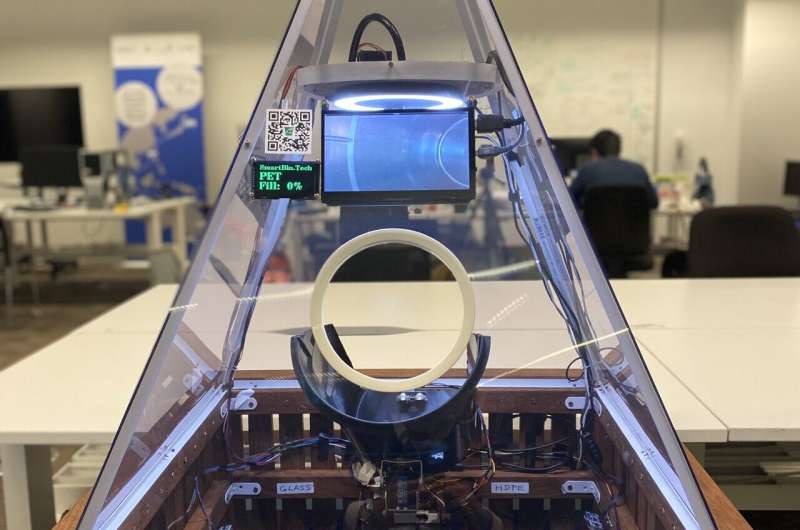Recycling robo-bin is among innovations to address circular economy gap

Australia’s national science agency, CSIRO, is unveiling the latest innovations in recycling this National Science Week to inspire the next generation of leaders who will lead our circular economy-focused future.
Students from year 6 at Marrickville Public School have joined CSIRO Chief Executive, Dr. Larry Marshall, and researchers from CSIRO and The University of Technology Sydney to test a new prototype “Smart Bin” and interact with construction materials made from recycled glass and polystyrene.
Smart Bin Technology uses Internet of Things (IoT), sensing, robotics, Artificial Intelligence (AI) and infrared spectroscopy technologies to automatically sort plastic, metal and glass, as well as sorting specific types of plastic. The bin is a proof of concept device designed to improve recycling rates and reduce contamination in waste streams, with New South Wales only recycling 10 percent of its 800,000 tons of plastic waste.
It also supports turning waste into a resource. Victorian small business Casafico creates commercial construction materials from recycled glass, newspaper and polystyrene, much of which is sourced through online waste exchange marketplace ASPIRE, which spun out of CSIRO in 2013.
CSIRO Chief Executive Dr. Larry Marshall said innovation and collaboration were essential to developing Australia’s circular economy and are at the heart of CSIRO’s collaborative Ending Plastic Waste Mission, which has a goal of an 80 percent reduction in plastic waste entering the Australian environment by 2030.
“Solutions from science that will grow our circular economy take collaboration at every stage of the innovation process—from understanding plastics at a molecular level to reinvent the way plastic is used, made, and recycled, through to commercializing solutions that use new technologies like this Smart Bin, which is now in discussions to go to market, and spinning out new companies like ASPIRE to grow new circular economy jobs,” Dr. Marshall said.
“Science can transform our economy into a circular one that renews and reuses what we previously discarded, creates higher paid jobs, advances new Australian technology, and protects our environment, while inspiring the next generation with what’s possible—during National Science Week and throughout the year.”
CSIRO Principal Research Scientist Wei Ni said, “Smart Bin Technology could be used at venues like shopping centers, schools, cinemas, coffee shops and airports. It will improve recycling rates because it is so easy to use and could ensure that materials can be recovered for reuse.”
UTS researcher Professor Ren Ping Liu said, “Working with CSIRO, we have developed the latest IoT and AI technologies to build this amazing Smart Bin. It can simplify the recycling process and improve efficiency for waste classification and sorting. The Smart Bin will help to promote the circular economy and contribute to a carbon neutral future.”
Casafico Head of Communications, Samantha Mucci spoke to the benefits of operating in the circular economy.
“Sourcing waste materials through Aspire helps us to become carbon positive, to save scarce natural resources and divert waste away from landfill,” she said.
“We can’t underestimate how small changes can make a huge difference. It’s great to see the next generation are learning that.”
In line with the 2022 National Science Week theme “Glass: more than meets the eye,” CSIRO has developed curriculum-aligned lesson plans with suggested class activities around the glass, plastic and the circular economy theme made available to support teachers nationwide. This continues CSIRO’s 40-year track record of actively supporting STEM (Science, Technology, Engineering and Mathematics) learning for students and teachers with high-quality education programs.
CSIRO’s 2021 Circular Economy Roadmap found innovation could triple job creation from resource recovery by designing new products and materials, advanced manufacturing, and in embracing new business models that will create domestic and export markets for waste streams. Increasing Australia’s recovery rate by just 5 percent would add an estimated $1 billion to GDP.
Citation:
Recycling robo-bin is among innovations to address circular economy gap (2022, August 17)
retrieved 17 August 2022
from https://techxplore.com/news/2022-08-recycling-robo-bin-circular-economy-gap.html
This document is subject to copyright. Apart from any fair dealing for the purpose of private study or research, no
part may be reproduced without the written permission. The content is provided for information purposes only.
For all the latest Technology News Click Here
For the latest news and updates, follow us on Google News.
